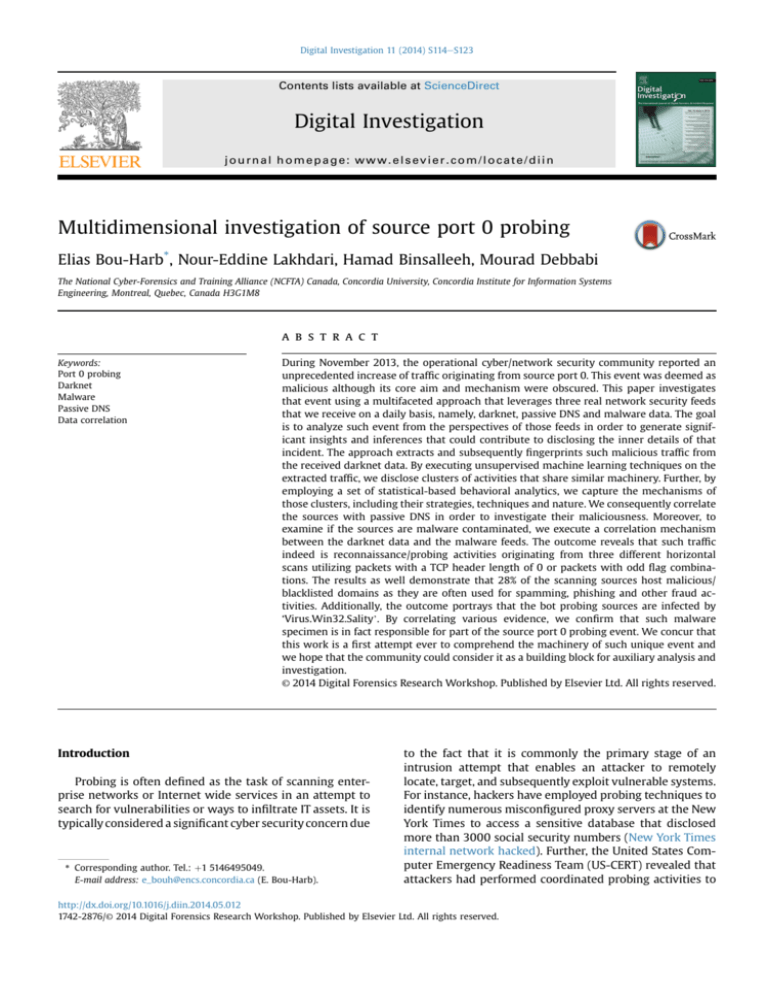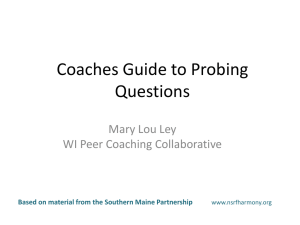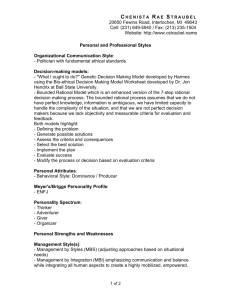
Digital Investigation 11 (2014) S114eS123
Contents lists available at ScienceDirect
Digital Investigation
journal homepage: www.elsevier.com/locate/diin
Multidimensional investigation of source port 0 probing
Elias Bou-Harb*, Nour-Eddine Lakhdari, Hamad Binsalleeh, Mourad Debbabi
The National Cyber-Forensics and Training Alliance (NCFTA) Canada, Concordia University, Concordia Institute for Information Systems
Engineering, Montreal, Quebec, Canada H3G1M8
a b s t r a c t
Keywords:
Port 0 probing
Darknet
Malware
Passive DNS
Data correlation
During November 2013, the operational cyber/network security community reported an
unprecedented increase of traffic originating from source port 0. This event was deemed as
malicious although its core aim and mechanism were obscured. This paper investigates
that event using a multifaceted approach that leverages three real network security feeds
that we receive on a daily basis, namely, darknet, passive DNS and malware data. The goal
is to analyze such event from the perspectives of those feeds in order to generate significant insights and inferences that could contribute to disclosing the inner details of that
incident. The approach extracts and subsequently fingerprints such malicious traffic from
the received darknet data. By executing unsupervised machine learning techniques on the
extracted traffic, we disclose clusters of activities that share similar machinery. Further, by
employing a set of statistical-based behavioral analytics, we capture the mechanisms of
those clusters, including their strategies, techniques and nature. We consequently correlate
the sources with passive DNS in order to investigate their maliciousness. Moreover, to
examine if the sources are malware contaminated, we execute a correlation mechanism
between the darknet data and the malware feeds. The outcome reveals that such traffic
indeed is reconnaissance/probing activities originating from three different horizontal
scans utilizing packets with a TCP header length of 0 or packets with odd flag combinations. The results as well demonstrate that 28% of the scanning sources host malicious/
blacklisted domains as they are often used for spamming, phishing and other fraud activities. Additionally, the outcome portrays that the bot probing sources are infected by
‘Virus.Win32.Sality’. By correlating various evidence, we confirm that such malware
specimen is in fact responsible for part of the source port 0 probing event. We concur that
this work is a first attempt ever to comprehend the machinery of such unique event and
we hope that the community could consider it as a building block for auxiliary analysis and
investigation.
© 2014 Digital Forensics Research Workshop. Published by Elsevier Ltd. All rights reserved.
Introduction
to the fact that it is commonly the primary stage of an
intrusion attempt that enables an attacker to remotely
locate, target, and subsequently exploit vulnerable systems.
For instance, hackers have employed probing techniques to
identify numerous misconfigured proxy servers at the New
York Times to access a sensitive database that disclosed
more than 3000 social security numbers (New York Times
internal network hacked). Further, the United States Computer Emergency Readiness Team (US-CERT) revealed that
attackers had performed coordinated probing activities to
Probing is often defined as the task of scanning enterprise networks or Internet wide services in an attempt to
search for vulnerabilities or ways to infiltrate IT assets. It is
typically considered a significant cyber security concern due
* Corresponding author. Tel.: þ1 5146495049.
E-mail address: e_bouh@encs.concordia.ca (E. Bou-Harb).
http://dx.doi.org/10.1016/j.diin.2014.05.012
1742-2876/© 2014 Digital Forensics Research Workshop. Published by Elsevier Ltd. All rights reserved.
E. Bou-Harb et al. / Digital Investigation 11 (2014) S114eS123
fingerprint WordPress sites and consequently launched
their targeted attacks (WordPress sites targeted). Moreover,
it was disclosed that hackers had leveraged sophisticated
scanning events to orchestrate multiple breaches of Sony's
PlayStation Network taking it offline for 24 days and costing
the company an estimated $171 million (PlayStation
network outage caused by ‘external intrusion’). More
alarming, a recent incident reported that attackers had
escalated a series of “surveillance missions” against cyberphysical infrastructure operating various US energy firms
that permitted the hackers to infiltrate the control-system
software and subsequently manipulate oil and gas pipelines (Iran hacks energy firms). Although, on one hand,
Panjwani et al. (2005) concluded that a momentous 50% of
attacks against cyber systems are preceded by some form of
probing activity, however, on the other hand, such observed
activities might simply reflect the “background radiation” of
various Internet-scale random scanning activities, remnants
of past worm/virus outbreaks, or other malware activities on
the global Internet at large (Moore et al., 2004). Indeed, it is
known in the cyber security and digital forensics communities that it is a daunting task to infer and uncover the
intention, mechanism and the nature of the perceived
probing activities (Jin et al., 2007).
Background
On November 2nd, 2013, security researchers at Cisco
Systems reported that their worldwide deployed sensors
have detected a massive increase in TCP source port 0 traffic.1
They further elaborated that the magnitude observed by the
sensors was elevated by 20 times than typical traffic originating from the same port and transport protocol on other
days. According to the researchers, such event renders the
largest spike in network traffic originating from TCP source
port 0 in the last decade. In a follow-up discussion,2 the researchers noted that such port, according to its RFC, is engineered to be reserved, and that such traffic could be used to
fingerprint various operating systems. Additionally, the security researchers speculated about the aim, mechanism and
source of that traffic by stating that such rare event could be
some sort of a research project, a malware infected probing
botnet, a targeted reconnaissance event aiming to launch an
immediate or a prolonged malicious task, or even a broken
embedded device or a new piece of malware with a bug in its
scanning code.
The event was interestingly also observed by DShield/
Internet Storm Center (ISC).3 ISC data comprises of millions
of intrusion detection log entries gathered daily from sensors covering more than 500 thousand Internet Protocol
(IP) addresses in over 50 countries. As shown in Fig. 1, the
event was apparent on four days, namely, November 2nd,4
November 21st, November 24th and November 25th, 2013.
The latter fact is particularly demonstrated by the peaks of
the TCP ratio of port 0 on those specific days.
1
2
3
4
http://tinyurl.com/pds443n.
http://tinyurl.com/n8j58hs.
http://www.dshield.org/port.html.
Coinciding with Cisco reports although not quite as significant.
S115
Fig. 1. The source port 0 event as observed by DShield/Internet Storm
Center.
Contributions
Motivated by the requirement to shed the light on that
incident in order to generate inferences and insights that
could contribute in disclosing the inner details of such an
unprecedented event, we frame the paper's contributions
as follows:
Proposing a multifaceted approach that leverages three
real network security feeds. The approach exploits darknet data (i.e., Internet traffic destined to half a million
routable yet unallocated IP addresses) to extract,
analyze and uncover the machinery of such traffic.
Further, the approach employs correlation between the
latter and passive DNS (i.e., Internet-wide authoritative
DNS responses) to study the maliciousness of the such
traffic. Moreover, the proposed approach correlates
darknet-extracted traffic with malware feeds to answer
questions related to contamination and attribution. To
the best of our knowledge, 1) the proposed approach
that correlates those three feeds in an effort to understand a cyber event has never been attempted before
and 2) the yielded outcome from adopting such an
approach related to this specific event is unique in the
literature.
Employing 1) machine learning data clustering techniques to partition the port 0 traffic according to similar
machinery and 2) a set of novel behavioral analytics that
scrutinize such traffic to capture the behavior of the
sources.
Evaluating the proposed approach using 30 GB of real
darknet traffic, 1.4 billion DNS records and 30 million
malware analysis reports.
Organization
The remaining of this paper is organized as follows. In
the following section, we present the proposed approach.
Specifically, we elaborate on how source port 0 traffic is
extracted and fingerprinted from darknet traffic in addition
to presenting the analytics that are used to disclose the
machinery of such traffic. Further, we discuss the goals and
S116
E. Bou-Harb et al. / Digital Investigation 11 (2014) S114eS123
Table 1
Features description.
Features
Data link layer
Network layer
Transport layer
1
2
3
4
5
6
7
8
9
10
11
12
13
14
15
16
17
18
19
20
21
22
23
24
25
26
27
28
29
Delta time with previous packet
Packet length
Frame length
Capture length
The flag ‘frame’ is marked
IP header length
IP flags
IP flags: reversed bit
IP flags: do not fragment bit
IP flags: more fragments bit
IP fragment offset
IP time to live
IP protocol
TCP segment length
TCP sequence number
TCP next sequence number
TCP acknowledgment number
TCP header length
TCP flags
TCP flags: congestion window
TCP flags: ECN-echo
TCP flags: urgent
TCP flags: acknowledgment
TCP flags: push
TCP flags: reset
TCP flags: syn
TCP flags: fin
TCP window size
UDP length
the correlation mechanisms with passive DNS and malware
data. In Section 3, we empirically evaluate the proposed
approach, which yields numerous insights related to the
source port 0 event, including, the traffic's machinery, the
maliciousness of the sources and their corresponding
malware attribution. In Section 4, we review the related
work on various concerned topics. Finally, concluding remarks and future work are stated in Section 5.
Proposed approach
In this section, we present the proposed approach that is
composed of three mechanisms, namely, darknet analysis,
passive DNS correlation and malware correlation.
Darknet analysis
We possess real darknet data that we are receiving on a
daily basis from a trusted third party. The data is around
12 GB per day. Such traffic originates from the Internet and
is destined to numerous network sensors. The data mostly
consists of unsolicited TCP, UDP and ICMP traffic. It might
contain as well some DNS traffic. In a nutshell, darknet
traffic is Internet traffic destined to routable but unused
Internet addresses (i.e., dark sensors). Since these addresses are unallocated, any traffic targeting them is
deemed as suspicious. Darknet traffic is typically composed
of three types of traffic, namely, probing, backscattered and
misconfiguration. Probing arises from bots, worms and
tools (or binaries) while backscattered traffic commonly
refers to unsolicited traffic that is the result of responses to
Denial of Service (i.e., DoS) attacks with spoofed source IP
addresses. On the other hand, misconfiguration traffic is
due to network/routing or hardware/software faults
causing such traffic to be sent to the darknet sensors.
Darknet analysis has shown to be an effective method to
generate Internet-scale cyber threat intelligence (Michael
et al., 2005).
Although the monitored darknet space is relatively large
(i.e., /13), we were unable to notice the existence of the
source port 0 event on November 2nd or November 21st.
However, we were able to retrieve around 30 GB of darknet
data that encompasses the event from November 24th and
25th. We base our darknet analysis approach on such data.
Traffic extraction
In order to retrieve the packets of the source port
0 event, we created a simplistic TCPdump filter5 that captures any darknet traffic that is utilizing TCP as the transport protocol and 0 as the source port. We applied the filter
upon the 30 GB darknet data. We further refined the output
by filtering out any darknet misconfiguration that could
exist. To accomplish this, we adopt a metric that records the
average number of sources per destination darknet
address. This metric should be significantly larger for misconfiguration than probing traffic. However, although it
differentiates misconfiguration from scanning, it could
include as well backscattered traffic as they also can
possess a large average number of sources per destination
(i.e, in case of a DoS). To cope with this issue, we observe,
per the technique in Wustrow et al. (2010), flags in packet
headers, such as TCP SYN þ ACK, RST, RST þ ACK, ACK, etc.,
that resemble backscattered traffic (Wustrow et al., 2010).
Subsequently, we filter out flows that lack that observation,
deeming them as misconfiguration. The remaining output
is rendered as the generated traffic from the source port
0 event, which is saved in a packet capture (i.e., pcap)
format for further analysis.
Traffic fingerprinting
To identify the nature of the source port 0 event, we
implemented the technique from Bou-Harb et al. (2014).
The latter approach specifically operates on darknet data
and possesses the capability to distinguish between probing and DoS sessions. To accomplish this, the technique
leverages the detrended fluctuation analysis statistical
method and assigns a certain unique correlation value
depending on the nature of each session. Readers who are
interested in the inner details of such technique are kindly
referred to Bou-Harb et al. (2014). By subjecting the source
port 0 event traffic to the technique, the outcome revealed
that 97% of the sessions are related to probing activities. We
manually inspected the remaining 3%, which demonstrated
that they are misconfiguration traffic that apparently, were
not previously filtered as expected. We also confirmed such
probing results by exposing the source port 0 event traffic
to Snort's6 probing engine, the sfPortscan pre-processor,7
which yielded a similar result.
5
6
7
http://www.danielmiessler.com/study/tcpdump/.
http://www.snort.org/.
http://manual.snort.org/node78.html.
E. Bou-Harb et al. / Digital Investigation 11 (2014) S114eS123
2.1.3. Traffic clustering
For the purpose of disclosing the inner mechanisms of
the source port 0 event, we refer to machine learning
techniques. Such techniques allow us to efficiently, effectively and automatically uncover clusters of activities
sharing similar machinery within the global event, without
relying on strenuous manual analysis.
When the data observations are not pre-labeled into
defined numerical or categorical classes, as in our case,
two standard widely deployed algorithms for data clustering using unsupervised learning could be employed.
These are the k-means (MacQueen et al., 1967) and the
EM (Dempster et al., 1977) algorithms. On one hand, the
k-means algorithm finds k clusters by choosing n data
points at random as initial cluster centers. Each data
point is then assigned to the cluster with the center that
is closest to that point. Each cluster center is then
replaced by the mean of all the data points that have been
assigned to that cluster. Note that, the k-means algorithm
operates by minimizing the sum of squared Euclidean
distances between data records in a cluster and the
clusters mean vector. This process is iterated until no data
point is reassigned to a different cluster. On the other
hand, the EM algorithm views the data clustering problem as a framework for data density estimation using a
probability density function. An effective representation
of the probability density function is the mixture model,
which asserts that the data is a combination of k individual component densities corresponding to k clusters.
The EM problem can be summarized as follows: given a
set of data observations, identify a set of k populations in
the data and provide a density distribution model of each
of the populations. Readers who are interested in the
details of the EM are kindly referred to Dempster et al.
(1977).
We proceed by going back to the source port 0 event
traffic pcap file that we have previously isolated. Subsequently, we extracted from it a total of 29 data link,
network and transport layer packet features as summarized in Table 1. The latter features have been shown to
produce distinguishing characteristics when applied on
network data (Alshammari and Nur Zincir-Heywood, 2011).
This feature extraction procedure was achieved using the
open source jNetPcap API.8 We consequently compiled the
extracted features into a unified data file and applied the kmeans and the EM algorithms, leveraging MATLAB's default
clustering functionality and the WEKA data mining tool,9
respectively.
Behavioral analytics
In an attempt to capture the machinery of the probing
sources/clusters, we present the following set of novel
behavioral analytics. Such proposed approach takes as
input the previously extracted probing sessions (recall
Section 2.1.2) and outputs a series of behavioral characteristics related to the probing sources. In what follows, we
pinpoint the concerned questions and subsequently
8
9
http://jnetpcap.com/.
http://www.cs.waikato.ac.nz/ml/weka/.
S117
present the undertaken approach in an attempt to answer
those.
Is the probing traffic random or does it follow a
certain pattern? When sources generate their probing
traffic, it is significant to capture the fashion in which they
accomplish that. To achieve this task, we proceed as follows. For each distinct pair of hosts retrieved from the
probing sessions (probing source to target), we test for
randomness in the generated traffic using the nonparametric WaldeWolfowitz statistic test. If the result is
positive, we record it for that specific probing source and
apply the test for the remaining probing sessions. If the
outcome is negative, we infer that the generated traffic
follows a certain pattern. To capture the specific employed
pattern, we model the probing traffic as a Poisson process
and retrieve the maximum likelihood estimate intervals (at
a 95% confidence level) for the Poisson parameter l that
corresponds to that traffic. The choice to model the traffic
as a Poisson distribution is motivated by Li et al. (2011),
where the authors observed that probe arrivals is coherent
with that distribution. After the test has executed for all the
probing sources, we apply the CLUstEring based on local
Shrinking (CLUES) algorithm on the generated patterns.
CLUES allows non-parametric clustering without having to
select an initial number of clusters. The outcome of that
operation is a set of specific l intervals. The aim of this is to
map each probing source that was shown to employ a
pattern to a certain l interval by removing overlapping
values that could have existed within the initially generated l intervals.
How are the targets being probed? As revealed in
Dainotti et al. (2012), coordinated probing sources employ
various strategies when probing their targets. These strategies could include IP-sequential, reverse IP-sequential,
uniform permutation or other types of permutations. In
an attempt to capture the probing strategies, we execute
the following. For each probing source, we extract its
corresponding distribution of target IPs. To differentiate
between sequential and permutation probing, we apply
the ManneKendall statistic test, a non-parametric hypothesis testing approach, to check for monotonicity in
those distributions. The rational behind the monotonicity
test is that sequential probing will indeed induce a
monotonic signal in the distribution of target IPs while
permutation probing will not. Further, in this work, we set
the significance level to 0.5% since a higher value could
introduce false positives. To differentiate between (forward) IP-sequential and reverse IP-sequential, for those
distributions that tested positive for monotonicity, we also
record the slope of the distribution; a positive slope defines a forward IP-sequential strategy while a negative one
renders a reverse IP-sequential strategy. For those distributions that tested negative for monotonicity (i.e., not a
sequential strategy), we leverage the chi-square goodnessof-fit statistic test. The latter insight will inform us
whether or not the employed strategy is a uniform permutation; if the test fails, then the employed strategy will
be deemed as a permutation; uniform permutation
otherwise.
What is the nature of the probing source? It is significant as well to infer the nature of the probing source; is
S118
E. Bou-Harb et al. / Digital Investigation 11 (2014) S114eS123
it a probing tool or a probing bot. From the two previous
questions, we can infer those probing events that are
random and monotonic. It is known that monotonic probing is a behavior of probing tools in which the latter
sequentially scan their targets (IPs and ports). Furthermore,
for random events, the monotonic trend checking can help
filter out traffic caused by the non-bot scanners (Li et al.,
2011). Thus, we deem a probing source as leveraging a
probing tool if their traffic is randomly generated and if
they adopt a sequential probing strategy (i.e., including
reverse IP-sequential); a bot otherwise.
Is the probing targeted or dispersed? When sources
probe their targets, it would be interesting to infer
whether their probing traffic is targeted toward a small
set of IPs or dispersed. To answer this, for each probing
source b, we denote GF(b) as the collection of flows
generated by that specific source that target the dark
space. The destination target IPs used by the flows in
GF(b) induce an empirical distribution. Subsequently, we
borrow the concept of relative uncertainty, an information theoretical metric and apply it on those distributions.
The latter index is a decisive metric of variety, randomness or uniformity in a distribution, regardless of the
sample size. An outcome that is close to 0 defines that the
probing source is using a targeted approach while an
outcome value close to 1 means that its corresponding
probing traffic is dispersed.
It is evident that the latter set of behavioral analytics
significantly depend on numerous statistical tests and
methods to capture the behavior of the probing sources.
We assert that such approach is arguably more sound than
heuristics or randomly set thresholds. It is also worthy to
mention that all the employed statistical tests assume that
the data is drawn from the same distribution. Since the
approach operates on one type of data, namely, darknet
data, we can safely presume that the values follow and are
in fact drawn from the same distribution.
12
10
8
6
4
2
0
2
4
6
8
10
12
14
16
Fig. 2. Port 0 event traffic clusters.
Hosting capability: Malicious entities typically host a
significant number of services and malicious domains
on a limited number of IP addresses for costeffectiveness reasons. Thus, by inferring domains that
are resolved to a specific IP address, we can pinpoint and
analyze these hosted domains to reveal the level of
maliciousness of that IP address.
Intensity: By computing the number of DNS messages
that utilize a certain IP address, we can deduce the levels
of accessibility and involvement of that IP address in
malicious activities.
Aliveness: By recording the first and last timestamp that
a specific IP address has been observed in DNS traffic
(i.e., resolved to certain domain(s)), we can infer the
participation period and aim of that IP address. Further,
we can refine the analyzed passive DNS interval for the
purpose of investigating and attributing that IP address
with a certain cyber event.
Passive DNS correlation
We are also receiving on a daily basis around 1.3 million
Domain Name System (DNS) messages from Farsight Security Inc. (Security Information Exchange). Such data is
collected by observing DNS traffic between recursive DNS
resolvers on the Internet. The latter is often dubbed as
passive DNS data, which constitutes the successful translations and associations between domains and IP addresses. Passive DNS analysis has shown to be an effective
approach to generate cyber threat intelligence (Bilge et al.,
2011). We amalgamate a database that contains the last
three-year period of such traffic (z1.4 billion records) in
order to investigate the source port 0 probing event.
The rationale of employing passive DNS correlation is
rendered by the requirement to contribute in investigating
and perhaps attributing the probing sources of such an
unprecedented event to certain malicious entities (i.e.,
malicious domains, for instance). Particularly, we aim to
extract the following information about the suspicious IP
addresses (previously retrieved from darknet analysis) that
have participated in the probing event.
Malware correlation
We possess as well dynamic malware analysis reports
(i.e., XML reports) of malware binaries for the last four
years. We are receiving such feed on a daily basis with an
average of 30 thousand XML malware reports from
ThreatTrack Security10. Up to the event date in November
2013, we have accumulated more than 30 million malware
analysis reports since January 2010. The XML reports are
produced by analyzing the malware binaries in a controlled
environment. Each XML report corresponds to only one
malware sample. It is worthy to mention that these reports
contain the executed activities by the malware samples at
the network and system levels. On one hand, the network
level activities refer to the connections and the exchanged
packets, including IP addresses, port numbers, urls, visited
domains and the actual payload data that has been sent. On
10
http://www.threattracksecurity.com/.
E. Bou-Harb et al. / Digital Investigation 11 (2014) S114eS123
the other hand, the system level activities constitute the list
of Dynamic-link Library (DLL) files that are utilized by the
malware, the key registry changes, and the memory usage.
We leverage such XML reports to investigate the source
port 0 probing event. Specifically, we attempt to answer the
following two questions by presenting their corresponding
approaches:
Which malware has infected the probing machines
before or during the occurrence of the event? In order to
infer which malware has infected the probing machines,
we present Algorithm 1. Simplistically, the Algorithm parses the XML reports mining for those malware that utilize
the probing machine IP addresses (previously retrieved
from darknet analysis) as per the destination IP address
criterion. The Algorithm further refines the output by only
considering those malware that connect to the probing IPs
in November 2013.
Algorithm 1. Extracting malware samples that have
infected the probing machines.
Which malware generated the probing traffic? In an
attempt to attribute the probing machines to a certain
malware, we perform the following. We filter the entire set
of malware XML reports by focusing on those samples that
execute traffic from TCP source port 0. We subsequently
match the outcome from the latter procedure with the list
of malware that infected the probing machines that was
derived from Algorithm 1. The rational behind this
approach states that if a certain machine has been infected
by a specific malware sample, in which it was derived that
such machine is generating TCP source port 0 traffic, then it
is highly probable that this specific malware is causing such
traffic.
Empirical evaluation
This section abides with the proposed approach that
was previously discussed to disclose various inferences
from the perspective of the three data feeds.
Darknet inferences
The source port 0 event traffic was rendered by more
than 1 million probing packets originating from TCP source
port 0 destined to the monitored darknet space. It is significant to note that we typically observe, on other days,
less than 1000 packets per darknet day originating from
TCP source port 0. The traffic originates from 27 unique
hosts, 17 distinct countries, 24 diverse Internet Service
S119
Providers (ISPs) and from within 25 operational organizations. We refrain from publishing statistics and rigorous
information related to the latter due to sensitivity and legal
issues. We next investigated some characteristics related to
those packets. We noticed that the Time to Live (TTL) values
of the packets change with the source IP addresses. This
advocates that IP spoofing is less likely or non-existent
(Templeton and Levitt, 2003). The fact that the source IP
addresses are not spoofed corroborates that such packets
are indeed related to scanning/probing activities (so the
actual scanner can essentially receive back the probing
results), as it was inferred in Section 2.1.2. We also noticed
that the packets arrival rate is slow, averaging around 3
packets per second. This is compliant with slow scanning
activities, which are known to be difficult to be detected
(Jaeyeon et al., 2004). Upon a closer investigation of the
packet headers, we observed that the majority of the
packets either include a TCP header length of 0 or are
malformed. Further, almost all the packets contain odd flag
combinations (i.e., FIN, SYN, RST, PSH, ACK, FIN, URG, PSH,
Reserved). Typically, probing by employing the latter flags
is considered as performing ‘stealthy’ scanning activities as
they are engineered to evade firewall detection by only
sending a single frame to a TCP port without any TCP
handshaking or any additional packet transfers (Bou-Harb
et al., 2013).
We proceed by executing the clustering approach in
coherence with Section 2.1.3. Recall, that the aim is to
disclose traffic clusters that share similar machinery. The
output of the EM algorithm is depicted in Fig. 2; we omit
the output of the k-means since it revealed a similar result.
Such outcome provides evidence that the traffic originates from 4 different classes. To further test the validity of
this result, we produced a silhouette graph of the EM
clusters as shown in Fig. 3. Commonly, a silhouette plot
displays a measure of how close each point in one cluster is
to points in the neighboring clusters. A value of 1 indicates
that the points are very distant from neighboring clusters, a
value of 0 informs that the points are not distant from other
clusters while a negative value indicates that the points are
erroneously placed in that cluster. From Fig. 3, it is shown
that a significant amount of points in all the 4 classes have a
large silhouette value, greater than 0.6 (Kaufman and
Rousseeuw, 2009), indicating that the clusters are separated from neighboring clusters. This provides incentives to
validate the quality of the formed EM clusters. By closely
investigating each cluster, we determined that the first
cluster represents a horizontal scan focused on destination
port 0 from a single IP address located in Germany targeting around 800 thousand unique destination addresses.
The use of destination port 0 is a frequently employed
technique by scanners to fingerprint the operating systems
of the targeted destinations in order to tailor future attacks
based on that retrieved information. Further, the second
cluster discloses a probing campaign targeting more than
60 thousand destination ports and originating from a single
Dutch IP address. The latter insight was also observed and
confirmed by Cisco.11 The third cluster renders another
11
http://tinyurl.com/kndnj82.
S120
E. Bou-Harb et al. / Digital Investigation 11 (2014) S114eS123
Fig. 3. A silhouette plot of the EM clusters.
Fig. 5. The nature of the blacklisted domains.
Fig. 4. Hosted and blacklisted domains of the probing sources.
horizontal scan that specifically targeted three destination
ports, namely, TCP ports 445, 22 and 3389, which respectively represent the Microsoft directory, the secure shell
(i.e., ssh) and the remote desktop protocol services. The
latter are known to suffer from various vulnerabilities and
are often exploited.12 It is worthy to mention that this
horizontal scan targeted 9 thousand destinations on port
445, 7 thousand destinations on port 22 and around 5.5
thousand destinations on port 3389. Recall, that all the
probing activities in the three previous clusters originate
from TCP source port 0. The last minor cluster captured
darknet misconfiguration traffic advocating the obtained
result of Section 2.1.2.
To further investigate the mechanisms of the probing
sources, we invoked the behavioral analytics that were
presented in Section 2.1.4. It was revealed that 62% of the
probing sources used certain patterns when generating
their probing traffic. Concerning the employed probing
strategy, it is shown that 57% of the probing sources
leveraged a permutation while the remaining adopted a
12
http://tinyurl.com/kkfs6pq,http://tinyurl.com/m5684jo.
sequential strategy when probing their targets. Of those
that employed a permutation, 76% used a uniform permutation while 24% adopted other types of permutations.
The majority (z98%) of those that employed a sequential
strategy were found to adopt a forward IP-sequential
strategy while only 2% adopted a reverse IP-sequential
strategy. It is noteworthy to mention that in Leonard and
Loguinov (2010), the researchers dismissed the possible
use of this strategy since, as they noted, the strategy is
difficult to be used to extrapolate certain metrics from
especially when dealing with partial probes. Further, the
analytics disclosed that z55% of the sources were probes
from bots while the remaining were generated from
probing tools. Moreover, it was inferred that all the probing
sources were generating probing that is dispersed as
opposed to targeting a small set of IPs. To the best of our
knowledge, the previously generated inferences represent
the first comprehensive empirical results of probing behaviors. In the context of the probing clusters that were
disclosed in the previous section, it was shown that clusters
Fig. 6. Investigating the aliveness and access count of the malicious
domains.
E. Bou-Harb et al. / Digital Investigation 11 (2014) S114eS123
Table 2
Malware samples generating TCP source
port 0 traffic.
Trojan-Down.Win32.Genome
Trojan.Win32.Badur
Trojan.Win32.Agent
Net-Worm.Win32.Kolab
HEUR:Backdoor.Win32
Backdoor.Win32.Ruskill
Virus.Win32.Sality
Backdoor.Win32.Azbreg
Worm.Win32.Ngrbot
0
5
10
15
20
25
30
Fig. 7. Malware and their corresponding number of connections.
one and two were generating random probing traffic as
opposed to using a certain pattern, employed a sequential
strategy when probing their targets and were found to be
leveraging a probing tool. The latter insight proposes that
such probing activities have been executed by the same
‘initiator/author’ since they are adopting the same mechanism and probing characteristics, which could reveal that
they both intended to achieve the same desired goal.
Conversely, in the third cluster, the majority (z92%) were
found to adopt certain patterns when generating their
probing traffic, employed a permutation when probing
their targets and were inferred to be bots. This suggests
that such probing activities could be malware-orchestrated
(Dainotti et al., 2012) and thus there is a momentous need
to explore and investigate their malevolence.
Passive DNS inferences
We employ the approach of Section 2.2 to investigate
the maliciousness of all the probing sources. Fig. 4 reveals
the top 10 probing IP addresses that were shown to host
(i.e., resolve to) the most domains. It could be inferred that
the most significant number of resolved domains ranges
from around 13 thousand domains to peaking at around
110 thousand domains per the probing IPs. We also investigated a subset of those domains that are related to malicious activities. To achieve this task, we correlated the
extracted domains with publically available datasets and
resources, namely, the Malware Domain List,13 Zeus
Tracker14 and McAfee's siteAdvisor.15 The outcome is also
depicted in Fig. 4, which reveals the number of blacklisted
domains. The fact that 28% of the probing IP addresses were
shown to host numerous blacklisted/malicious domains
provides an alarming signal that the source port 0 probing
traffic could be originating from a malicious entity with
malevolent goals. To identify the nature of those blacklisted
domains, we leveraged the Web of Trust reputation system.16 The outcome from such a procedure is depicted in
Fig. 5. The results demonstrate that more than half of the
13
14
15
16
S121
http://www.malwaredomainlist.com/.
https://zeustracker.abuse.ch/.
http://www.siteadvisor.ca/.
https://www.mywot.com/.
Email-Worm.Win32.Mydoom
Worm.Win32.AutoRun
Virus.Win32.Sality
Virus.Win32.Expiro
Backdoor.Win32.Xtoober
Trojan-Downloader.Win32.Agent
Trojan-Dropper.Win32.Small
Trojan.Win32.Pincav
Trojan.Win32.Jorik
Trojan-Downloader.Win32.Delf
Trojan-Downloader.Win32.Genome
Backdoor.Win32.Gbot
Backdoor.Win32.Popwin
Email-Worm.Win32.Rays
Email-Worm.Win32.Runouce
Packed.JS.Agent
Trojan-Banker.Win32.Banker
Trojan-Downloader.Win32.FlyStudio
Backdoor.Win32.Banito
Backdoor.Win32.VB
HackTool.Win32.Injecter
malicious domains could be attributed to malware; this
advocates our decision to leverage malware data to investigate the event in question. It was also shown that those
malicious domains are blacklisted as they are often used for
spamming, phishing and other fraud activities. We further
investigated those malicious domains by analyzing their
aliveness and intensity as discussed in Section 2.2 and
exposed in Fig. 6. One can notice, on one hand, that some
IPs with their corresponding blacklisted resolved domains
retain less active days but possess high accessibility, which
render them extremely effective in their maliciousness. On
the other hand, some domains have a prolonged online
presence yet possess low access counts. We envision that
such malicious domains are intentionally not intended to
be accessed but are rather playing a hosting or a supporting
(i.e., back-end) role for other malicious tasks and services.
Malware inferences
Motivated by the fact that the sources of the 3rd probing
cluster, as revealed in Section 3.1, were inferred to be bots
coupled with the conclusion that more than half of the
probing sources resolve to malware-infected domains as
demonstrated in Fig. 5, in this section, we investigate the
source port 0 probing event from the malware feed
perspective, in accordance with the proposed approach of
Section 2.3.
Fig. 7 depicts the malware samples and their corresponding number of connections to the probing machines.
It could be noted that the malware specimens, namely,
Sality and Ngrbot, indeed refer to bot families.17 Further,
Table 2 reveals the malware samples that generated TCP
source port 0 traffic.
17
http://www.symantec.com/connect/blogs/all-one-malwareoverview-sality.
S122
E. Bou-Harb et al. / Digital Investigation 11 (2014) S114eS123
By correlating Fig. 7 and Table 2, we can notice that
‘Virus.Win32.Sality’ is the common factor. In other words,
such malware sample has infected some of the probing
machines and is simultaneously generating TCP source port
0 traffic. It is noteworthy to mention that such sample has
been previously attributed to malicious activities; Dainotti
et al. (2012) had documented a large-scale probing
campaign that was able to probe the entire IPv4 address
space in 12 days. Interestingly, the authors pinpointed that
the malware responsible for such campaign was in fact the
Sality malware. Thus, from all the extracted insights and by
leveraging the three data feeds, we strongly postulate that
‘Virus.Win32.Sality’ is responsible for part of the TCP
source port 0 event.
Related work
In this section, we review the literature related to
various concerned topics.
Analyzing Probing Events: The authors of Yu et al.
(2007a,b) studied probing activities toward a large
campus network using netflow data. Their goal was to infer
the probing strategies of scanners and thereby assess the
harmfulness of their actions. They introduced the notion of
gray IP space, developed techniques to identify potential
scanners, and subsequently studied their scanning behaviors. In another work, the authors of Li et al. (2009, 2011)
presented an analysis that drew upon extensive honeynet
data to explore the prevalence of different types of scanning. Additionally, they designed mathematical and
observational schemes to extrapolate the global properties
of scanning events including total population and target
scope.
Probing Measurement Studies: In addition to Dainotti
et al. (2012) and Internet census (2012), Benoit and Trudel
(2007) presented the world's first Web census while
Heidemann et al. (2008) were among the first to survey
edge hosts in the visible Internet. Further, Pryadkin et al.
(2004) offered an empirical evaluation of IP address space
occupancy whereas Cui and Stolfo (2010) presented a
quantitative analysis of the insecurity of embedded
network devices obtained from a wide-area scan. In a
slightly different work, Leonard and Loguinov (2010)
demonstrated IRLscanner, a tool which aimed at maximizing politeness yet provided scanning rates that achieved coverage of the Internet in minutes.
Malware and Probing Correlation: Nakao et al. (2009)
were among the first to exploit the idea of correlating
malware and probing activities to detect zero-day attacks.
The authors leveraged the nicter framework (Inoue et al.,
2008) to study the inter-relations between those two activities. They developed scan profiles by observing the dark
space and correlated them with malware profiles that had
been generated in a controlled environment. In an another
closely related work, Song et al. (2011) carried out correlation analysis between 10 spamming botnets and
malware-infected hosts as observed by honeypots. They
disclosed that the majority of the spamming botnets have
been infected by at least four different malware. The authors as well developed methods to identify which exact
malware type/family has been the cause of contamination.
In a marginally diverse effort, Eto et al. (2009) proposed a
malware distinction method based on scan patterns by
employing spectrum analysis. The authors stated that by
observing certain probing patterns, one can recognize the
similarities and dissimilarities between different types of
malware. The authors noted that the latter could be used as
a fingerprint to effectively infer infection.
Passive DNS Correlation: Correlating DNS activity with
IP traffic has been employed to detect malware scanning
activities. Since probing techniques do not typically use
DNS messages, Whyte et al. (2005) proposed an approach
to monitor network traffic and correlate it with any
observed DNS messages. Similarly, in Whyte et al. (2006),
the same authors addressed the problem of mass-mailing
worm activities by utilizing DNS MX messages and SMTP
server operations. In order to track scam infrastructure,
Konte et al. (2009) correlated some known spam URLs with
passive DNS traffic to understand the dynamics of hosting
scam campaigns. In alternative works, passive DNS traffic
has been used to address the problem of domain blacklisting. For instance, Notos (Antonakakis et al., 2010) and
EXPOSURE (Bilge et al., 2011) utilized some behavioral
features that are extracted from passive DNS traffic to
detect malicious domain names. In a slightly differed work,
DNS patterns from the upper DNS hierarchy has been
analyzed and deployed in a system dubbed as Kopis
(Antonakakis et al., 2011) to extend and detect new related
malicious domains. Last but not least, Pleiades
(Antonakakis et al., 2012) used passive DNS to tackle the
problem of Domain Generation Algorithms by observing
NXDOMAIN DNS response messages.
It is indeed evident that the presented work is unique by
employing and correlating three real data feeds, namely,
darknet, passive DNS and malware data, to analyze, understand and extract inferences related to an unprecedented, previously unanalyzed cyber event, explicitly, the
source port 0 probing event.
Conclusion
This paper investigated a rare cyber event that was
rendered by excessive traffic originating from source port 0.
The goal was to shed the light on the inner details of that
event to uncover its mechanism and nature of its sources.
To achieve those goals, we proposed a multifaceted
approach that exploited and correlated a significant
amount of real network security data, including, darknet,
passive DNS and malware information. The outcome
revealed three probing clusters, in which one of them was
shown to be originating from infected bots. By analyzing
the maliciousness of the probing sources, the approach
uncovered that 28% of those are related to malicious domains. Further, by correlating darknet and malware data,
the approach was capable of attributing part of the event to
the Sality malware. We envision that such approach could
be applicable to analyze other cyber events with similar
nature. As for future work, we are working on extending
the proposed approach by investigating similarity mechanisms between extracted malicious darknet traffic and
generated malware traffic to fortify the attribution
evidence.
E. Bou-Harb et al. / Digital Investigation 11 (2014) S114eS123
Acknowledgment
The authors are grateful for NCFTA Canada, Concordia
University and the Natural Sciences and Engineering
Research Council of Canada (NSERC) for supporting this
work. The first author is supported by the Alexander Graham Bell Canada Graduate Scholarship (CGS) from NSERC.
References
Alshammari Riyad, Nur Zincir-Heywood A. Can encrypted traffic be
identified without port numbers, ip addresses and payload inspection? Comput Netw 2011;55(6):1326e50. ISSN 1389-1286. Doi: 10.
1016/j.comnet.2010.12.002. http://www.sciencedirect.com/science/
article/pii/S1389128610003695.
Antonakakis Manos, et al. Building a dynamic reputation system for dns.
In: Proceedings of the 19th USENIX conference on security; 2010.
Antonakakis Manos, et al. Detecting malware domains at the upper DNS
hierarchy. In: USENIX security symposium; 2011.
Antonakakis Manos, et al. From throw-away traffic to bots: detecting the
rise of DGA-based malware. In: Proceedings of the 21st USENIX security symposium; 2012.
. World's first web census. Int J Web Inf Syst;
Benoit Darcy, Trudel Andre
2007.
Bilge Leyla, et al. Exposure finding malicious domains using passive DNS
analysis. In: NDSS symposium 2011; 2011.
Bou-Harb E, Debbabi M, Assi C. Cyber scanning: a comprehensive survey.
Commun Surv Tutor IEEE PP 2013;99:1e24.
Bou-Harb Elias, Debbabi Mourad, Assi Chadi. On fingerprinting probing
activities. Comput Secur 2014;43(0):35e48.
Cui Ang, Stolfo Salvatore J. A quantitative analysis of the insecurity of
embedded network devices: results of a wide-area scan. In: The 26th
annual computer security applications conference. New York, NY,
USA: ACM; 2010.
Dainotti Alberto, et al. Analysis of a “/0” stealth scan from a botnet. In: The
2012 ACM conference on internet measurement conference, IMC '12.
ACM; 2012.
Dempster AP, Laird NM, Rubin DB. Maximum likelihood from incomplete
data via the em algorithm. J R Stat Soc Ser B Methodol; 1977:1e38.
Eto Masashi, et al. A proposal of malware distinction method based on
scan patterns using spectrum analysis. In: Leung Chi Sing, Lee Minho,
Chan Jonathan H, editors. Neural information processing. Springer
Berlin Heidelberg; 2009. pp. 565e72.
Heidemann John, et al. Census and survey of the visible internet. In: The
8th ACM SIGCOMM conference on internet measurement. New York,
NY, USA: ACM; 2008.
Inoue D, et al. nicter: An incident analysis system toward binding network
monitoring with malware analysis. In: Information security threats
data collection and sharing, 2008. WISTDCS '08; 2008.
Internet census 2012 e port scanning/0 using insecure embedded devices. http://tinyurl.com/c8af8lt.
Iran hacks energy firms. http://tinyurl.com/opjw79c.
Jaeyeon Jung, et al. Fast portscan detection using sequential hypothesis
testing. In: 2004 IEEE S&P. IEEE; 2004.
Jin Yu, Simon Gyorgy, Xu Kuai, Zhang Zhi-Li, Kumar Vipin. Gray's anatomy: dissecting scanning activities using ip gray space analysis.
SysML07; 2007.
S123
Kaufman Leonard, Rousseeuw Peter J. Finding groups in data: an introduction to cluster analysis, vol. 344. John Wiley & Sons; 2009.
Konte Maria, Feamster Nick, Jung Jaeyeon. Dynamics of online scam
hosting infrastructure. In: Passive and active network measurement.
Springer; 2009. pp. 219e28.
Leonard Derek, Loguinov Dmitri. Demystifying service discovery: implementing an internet-wide scanner. In: The 10th ACM SIGCOMM
conference on internet measurement. New York, NY, USA: ACM; 2010.
Li Zhichun, Goyal Anup, Chen Yan, Paxson Vern. Automating analysis of
large-scale botnet probing events. In: The 4th international symposium on information, computer, and communications security,
ASIACCS '09. New York, NY, USA: ACM; 2009.
Li Zhichun, et al. Towards situational awareness of large-scale botnet
probing events. IEEE Trans Inf Forensics Secur; 2011.
MacQueen J, et al. Some methods for classification and analysis of
multivariate observations. In: Proceedings of the fifth Berkeley symposium on mathematical statistics and probability, vol. 1; 1967. p. 14.
California, USA.
Michael Bailey, et al. The internet motion sensor-a distributed blackhole
monitoring system. In: NDSS; 2005.
Moore David, Shannon Colleen, Voelker Geoffrey M, Savage Stefan.
Network telescopes: technical report. San Diego: Department of
Computer Science and Engineering, University of California; 2004.
Nakao Koji, et al. Practical correlation analysis between scan and malware
profiles against zero-day attacks based on darknet monitoring. IEICE
Trans Inf Syst; May 2009.
New York Times internal network hacked. http://tinyurl.com/cvnrsac.
Panjwani S, et al. An experimental evaluation to determine if port scans
are precursors to an attack. In: The international conference on
dependable systems and networks. DSN 2005; 2005. pp. 602e11.
PlayStation network outage caused by ‘external intrusion’. http://tinyurl.
com/6cbcldv.
Pryadkin Y, Lindell R, Bannister J, Govindan R. An empirical evaluation of
IP address space occupancy. USC/ISI technical report ISI-TR; 2004.
Security Information Exchange (SIE). Farsight Security Inc. https://www.
farsightsecurity.com.
Song Jungsuk, et al. Correlation analysis between spamming botnets and
malware infected hosts. In: 2012 IEEE/IPSJ 12th international symposium on applications and the internet; 2011.
Templeton Steven J, Levitt Karl E. Detecting spoofed packets. In: DARPA
information survivability conference and exposition, 2003. Proceedings, vol. 1. IEEE; 2003. pp. 164e75.
Whyte David, Kranakis Evangelos, van Oorschot Paul C. DNS-based
detection of scanning worms in an enterprise network. In: NDSS;
2005.
Whyte David, van Oorschot Paul C, Kranakis Evangelos. Addressing SMTPbased mass-mailing activity within enterprise networks. In: Computer security applications conference, 2006. ACSAC'06. 22nd annual.
IEEE; 2006. pp. 393e402.
WordPress sites targeted by mass brute-force attack. http://tinyurl.com/
cxmgjax.
Wustrow Eric, et al. Internet background radiation revisited. In: Proceedings of the 10th annual conference on internet measurement.
ACM; 2010. pp. 62e74.
Yu Jin, et al. Gray's anatomy: dissecting scanning activities using IP gray
space analysis. Usenix SysML07; 2007.
Yu Jin, et al. Identifying and tracking suspicious activities through IP gray
space analysis. In: The 3rd annual ACM workshop on mining network
data. New York, NY, USA: ACM; 2007.









